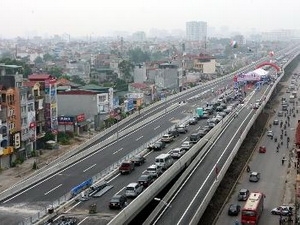Giant belt road on path to construction
 The $4.7 billion belt route No.5 project’s mid-term report was approved in early August and its estimated investment scale was now available, said Ministry of Transport (MoT) chief of office Nguyen Van Luu.
The $4.7 billion belt route No.5 project’s mid-term report was approved in early August and its estimated investment scale was now available, said Ministry of Transport (MoT) chief of office Nguyen Van Luu.
“Hanoi’s outer beltway initial shaping is now relatively clear,” said MoT’s Thang Long Project Management Unit (PMU) director Vu Xuan Hoa. Thang Long PMU has taken charge of drawing the beltway project’s detailed planning.
Accordingly, the belt route No.5 will include highway and road sections from four to six lanes. The 385km belt route will run through eight provinces and cities, including Hanoi, Hoa Binh, Ha Nam, Thai Binh, Hai Duong, Bac Giang, Thai Nguyen and Vinh Phuc, connecting with huge satellite urban centres around Hanoi within a radius of 50-60 kilometres. The overall project will be finished by 2030.
In the near-term, both highway and normal road sections will consist of two-four lanes only in order to get the entire belt route 5’s complete version soon in place.
The Transport Engineering Design Incorporation (TEDI), the project’s planning consultant, suggested that the belt route No. 5 would pass scores of key routes turning to Hanoi such as the Ho Chi Minh road, Cau Gie- Ninh Binh highway, Hanoi- Lang Son highway and Hanoi- Thai Nguyen highway.
Apart from recalculating investment scale, the MoT required TEDI to work with the local authorities on the direction of the route, investment phases and closely study localities’ planning to take advantage of on-going projects.
“The MoT asked the TEDI to finish the detailed planning to submit the prime minister in 2012’s fourth quarter,” said Luu.
What the stars mean:
★ Poor ★ ★ Promising ★★★ Good ★★★★ Very good ★★★★★ Exceptional
 Tag:
Tag:
Latest News
More News
- Global partnerships key to Vietnam’s IFC development (December 26, 2025 | 16:18)
- Vingroup pulls out of bid to invest in North-South high-speed railway (December 26, 2025 | 11:42)
- Strengthening supply chains through trade promotions and customs reform (December 24, 2025 | 14:00)
- PM orders investment model for North–South high-speed rail (December 22, 2025 | 17:43)
- LS Eco Energy to invest in Vietnam rare earth sector (December 22, 2025 | 17:31)
- Government moves to establish International Financial Centre (December 21, 2025 | 21:00)
- Vietnam's IFC to target global investment flows (December 21, 2025 | 18:00)
- Two national hospitals expand capacity with new facilities (December 20, 2025 | 09:00)
- Ha Tinh breaks ground on major Vingroup industrial and energy projects (December 19, 2025 | 18:24)
- EVN launches major power infrastructure projects nationwide (December 19, 2025 | 18:17)
















 Mobile Version
Mobile Version